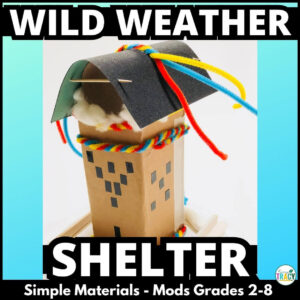If you’re looking to apply learning in weather, climate, natural disasters, natural resources & more, this STEM / STEAM challenge is a perfectly engaging way to get the job done joyfully!
The basic premise:
Students work individually or in partners/groups against a list of criteria and constraints to create the a shelter to defend against 3+ types of weather and/or disasters.
This challenge was developed as part of the Planetopia Project, but it can be used as a stand-alone challenge as well.
Check out the video preview to see what is included in this resource:
Note: If you are in a 1:1 classroom, you may prefer the
digital format, compatible with Google Slides ™ coming by May 10, 2018.
Resource includes:
- NGSS aligned standards, Grades 2 – 8
- Teacher Tips:
- Links to my 5-part video series on getting started with STEM challenges
- Materials and timing
- Criteria & Constraints (including modifications to increase difficulty for older students)
- Measuring results
- Universal STEM Challenge Notes & How to Use Student Handouts
- Post-design extension activities list
- Link to a video walk-through of the challenge
- Student Handouts:
- Planning Pages
- Criteria & Constraints List (in color and B&W; editable version provided)
- Results and Design Analysis (2-page regular spacing and 4-page expanded) spacing for primary students included in color and and B&W)
- Discussion Questions (color and B&W)
- Extension templates
- Evaporation Diagram
- The Water Cycle Diagram
- Shelter Ratings Activity
- Shelter Superlatives Template
- Weather Graph
- Weather Forecasting Activity Template
- Postcard Writing Templates
- Process flow map
- Create & solve math problems based on designs
Sample/suggested materials for each student or group:
(Materials you’ll need to do the activity are easily modified. You don’t need to provide all of the following materials. Select a subset and/or add in your own ideas.)
-
- Note: The links below are Amazon Affiliate links. Find out more on the disclosure page.

For Building:
- Cardboard scraps / paper plates / small cups
- Craft sticks / wooden coffee stirrers
- Pipe cleaners
- Masking or packing tape
- Cotton
- Sand Paper
- Plastic wrap, bags, or balloons
- Zip ties or string
- Scissors, hole punch and/or nails/screwdrivers
Optional
- Crayola Model Magic or clay
- Hot glue gun
- Foil
- Construction paper / tissue
- Coffee filters
- Pompoms
- Foil
- Paperclips
- Toothpicks

For Measuring Results:
- Plastic bin or foil tray (shoebox size works well)
- Water
- Tissue paper
- Thermometers
- Spray bottles
- Fan or hair dryer
- Cotton balls or batting
- Beads, rice, or marbles
- Molasses or mud
- Gravel, rocks, or sand
Benefits of this STEM Design Challenge:
- Focus on critical thinking, problem solving, and application of learning
- Helps students develop growth mindset traits like persistence and resilience
- High levels of student engagement
- The potential to hit upon all NGSS ETS standards depending on the depth and number of iterations you choose to implement in your classroom (modifications included)
- Highly flexible and differentiated for materials, timing, grade levels, and rigor.
Each design iteration should be planned for ~60 min. if you are including data gathering and analysis rather than just building for fun. If you add extension activities, you will need to adjust timing accordingly.
This resource is also available in paperless format and in the Mega Bundle. It will soon be also be available in a discounted Planetopia Project bundle.



If you prefer to purchase on TpT, click here.
Note: any coupon/promo codes for this site will only work on this site. TpT does not have the option for individual stores to offer promo codes.
Preview Music Credit:
“Carefree” Kevin MacLeod (incompetech.com)
Licensed under Creative Commons: By Attribution 3.0 License
http://creativecommons.org/licenses/by/3.0/











Reviews
There are no reviews yet.